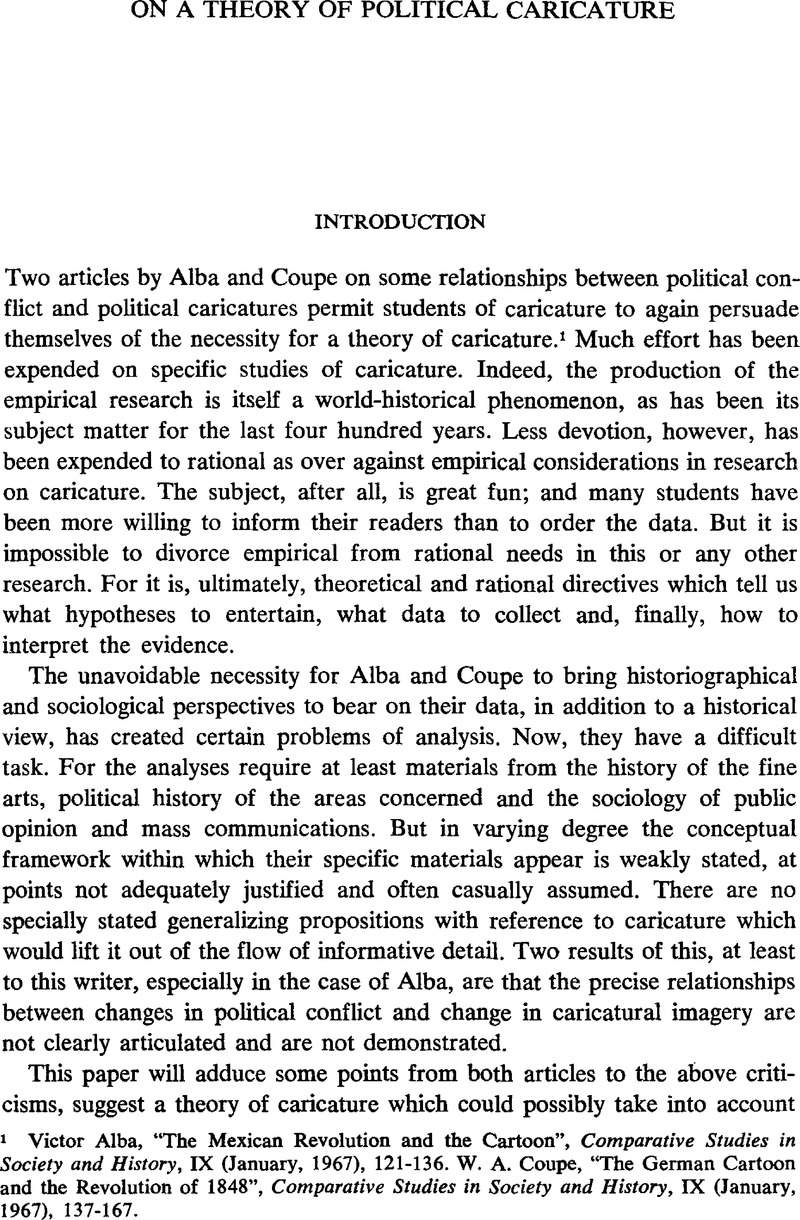Article contents
On a Theory of Political Caricature
Published online by Cambridge University Press: 03 June 2009
Abstract

- Type
- Debate: Political Cartooning
- Information
- Copyright
- Copyright © Society for the Comparative Study of Society and History 1967
References
1 Alba, Victor, “The Mexican Revolution and the Cartoon”, Comparative Studies in Society and History, IX (January, 1967), 121–136CrossRefGoogle Scholar. Coupe, W. A., “The German Cartoon and the Revolution of 1848”, Comparative Studies in Society and History, IX (January, 1967), 137–167CrossRefGoogle Scholar.
2 Cf. my article “David Low and the Sociology of Caricature”, Comparative Studies in Society and History, VIII (October, 1965), 1–23Google Scholar, for an analysis of Colonel Blimp and a “fool-making” process. A shorter version of this paper was presented at the annual meetings of the American Sociological Association, Chicago, August-September, 1965.
3 Ashbee, C. R., Caricature (London, Chapman and Hall, Ltd., 1928), p. 30Google Scholar.
4 Benjamin, Walter, “The Work of Art in the Epoch of Mechanical Reproduction”, Gerth, H. H. and Martindale, Don, translators, Studies on the Left, I (Winter, 1960), 28–46Google Scholar.
5 Ibid., p. 33.
6 Ibid., pp. 31–32.
7 Cf. Kracauer, Siegfried, Theory of Film: The Redemption of Physical Reality (New York, Oxford University Press, 1960), pp. 29–30Google Scholar.
8 Benjamin, op. cit., p. 41. See also Hauser, Arnold, The Social History of Art (New York, Alfred A. Knopf, 1952), II, 927–959Google Scholar, for a comparable analysis of the modern film and Kracauer, op. cit., passim.
9 Albig, William, Modern Public Opinion (New York, McGraw-Hill Book Company, 1956), p. 5Google Scholar.
10 See, e.g., my article “David Low and the Mass Press”, Journalism Quarterly, XLIII (Summer, 1966), 211–220Google Scholar, for a comment on this procedure. A similar version, “Techniques of Mass Persuasion in the Caricature of David Low”, was presented at the annual meeting of the American Psychological Association, New York, September, 1966Google Scholar.
11 Speier, Hans, “Historical Development of Public Opinion”, American Journal of Sociology, LV (January, 1950), 376–388CrossRefGoogle ScholarPubMed.
12 Born, Wolfgang, “The Nature and History of Medical Caricature”, Ciba Symposia, VI (November, 1944), 1910Google Scholar.
13 Loc. cit.
14 Kahnweiler, Daniel-Henry, Juan Gris: His Life and Work (London, Lund Humphries, 1947), pp. 51–52Google Scholar.
15 Goldwater, Robert, Paul Gaugin (London, Thames and Hudson, 1957), pp. 9, 142Google Scholar.
16 Loc. cit.
17 Low, David, Ye Madde Designer (London, The Studio Limited, 1935), p. 18Google Scholar, makes this contribution to caricatural technique.
18 Eisenstein, Sergei, Film Form, ed. and transl. by Leyda, Jay (New York, Meridian Books, Inc., 1959), pp. 28–44Google Scholar.
19 Kris, Ernst, Psychoanalytic Explorations in Art (London, George Allen & Unwin, Ltd., 1953), pp. 373–380Google Scholar. Franz Xavier Messerschmidt (1736–1783) was a student at the Academy of Vienna under Matthaus Donner and Jacob Schletterer. He was never on good relations with the Vienna school and lived the life of a hermit at Presbourg. He was famous for his sixty character heads, a few of which are shown in the above reference. The sculptures evoked the contemporary research of Lavater, Johann Caspar, Essays on Physiognomy, Designed to Promote the Knowledge and Love and Mankind, transl. Hunter, Henry (London, J. Murray, 1789–1798Google Scholar), on the same subject. The sculptures were inspired partially by the theories of Friedrich Anton Mesmer (1734–1815), a Viennese physician, with whom Messerschmidt also was a friend. From Mesmer we get the word “mesmerize” which means “to hypnotize” and the sculptured heads appear to be a partial result of Mesmer's theories which held that a person's expressions could be “frozen” at the command of the hypnotist. The caricaturist, as it were, may be thought to “freeze” the expression on a figure's face, thereby sociologically typing the person with a standard expression and defining character with this mask or hieroglyphic. Political events provide the clinical milieu. But this also suggests that caricatural influence may be based on ad hoc situations and divorced from a socio-cultural legacy or history of symbols. If we hold this legacy constant or divorce a reading public from it, a certain kind of manipulation and influence may be possible.
20 See George, M. Dorothy, English Political Caricature to 1792 and 1792–1832: A Study of Opinion and Propaganda (Oxford, At the Clarendon Press, 1959Google Scholar), for contributions to such a language.
21 Some of these techniques applied to politics are shown in my paper “Political Themes in the Caricatures of David Low”, presented at the meetings of the Sixth World Congress of Sociology, Evian, France, September, 1966.
22 Burke, Kenneth, A Grammar of Motives (New York, Prentice-Hall, 1945), pp. 282–283Google Scholar, 503–509.
23 Albig, op. cit., pp. 369–385.
24 Supra, n. 10.
25 See, e.g., the studies cited in Albig, op. cit., and Berelson, Bernard, Content Analysis in Communication Research (Glencoe, The Free Press, 1952Google Scholar).
26 Supra, n. 20.
27 Sorokin, Pitirim A., Social and Cultural Dynamics (New York, American Book Company, 1937), I, 490–491Google Scholar.
28 Riesman, David in his analysis of the “other-directed character” type in The Lonely Crowd (New Haven, Yale University Press, 1950Google Scholar), would seem t o support this point as he analyzes the segmental manner in which some contemporary personalities reciprocate social expectations.
- 59
- Cited by


